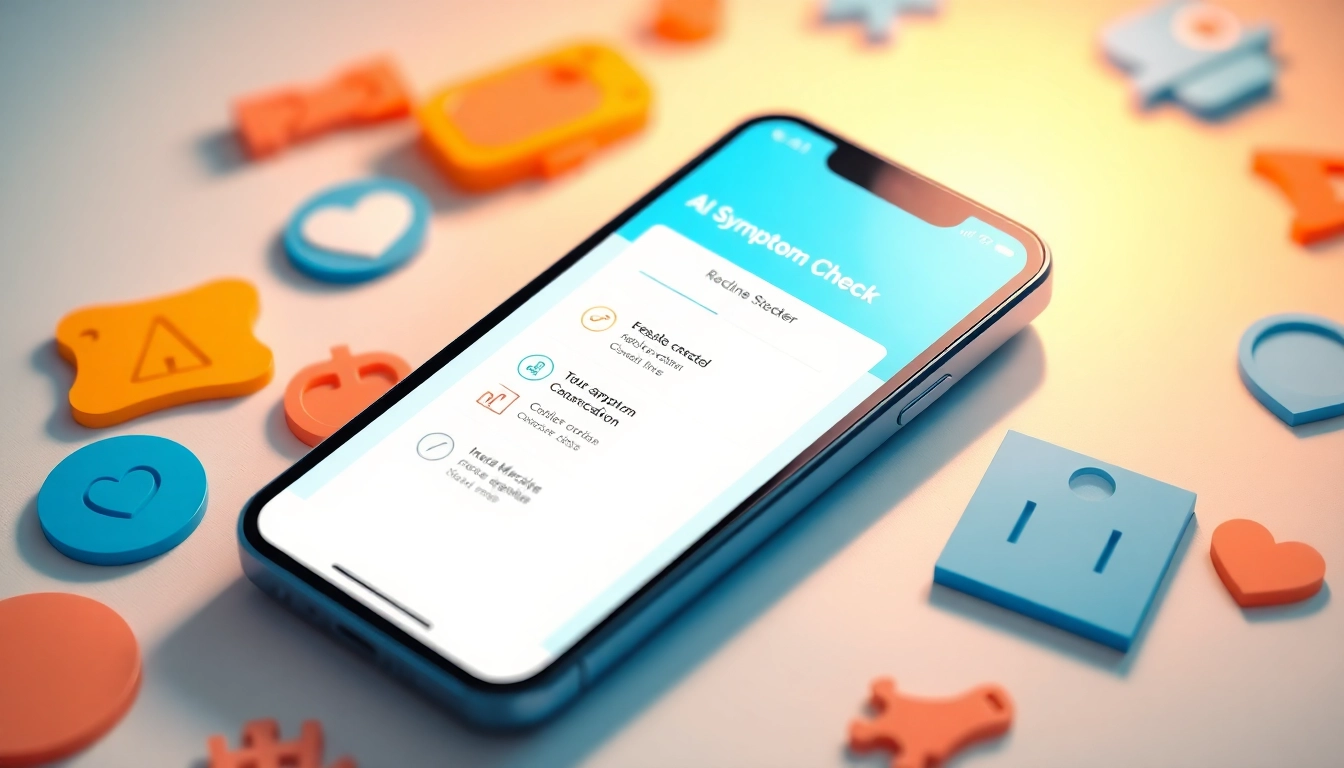Understanding the AI Symptom Checker Basics
What Is an AI Symptom Checker?
An AI symptom checker is a digital tool that leverages artificial intelligence to assist users in identifying potential health issues based on the symptoms they describe. These sophisticated systems gather user-inputted data, analyze it against a vast database of medical knowledge, and often provide possible diagnoses or recommendations for further action. They represent a fusion of technology and medical intelligence designed to enhance the efficiency of healthcare delivery.
How AI Symptom Checkers Work
AI symptom checkers utilize complex algorithms and machine learning models to interpret symptoms reported by users. The process generally begins with the user entering their symptoms into a user-friendly interface. The underlying technology then performs a few critical tasks:
- Data Collection: Users provide a detailed account of their symptoms, including onset, duration, severity, and additional health information.
- Natural Language Processing (NLP): This component allows the AI to understand and interpret the user’s symptoms as they are phrased, which may vary from person to person.
- Database Cross-Referencing: The AI compares the input data against a large database of medical knowledge, including symptoms, conditions, and potential causes.
- Diagnostic Suggestion: Based on the analysis, the AI provides potential conditions that may correlate with the symptoms described or recommends further actions, such as seeing a healthcare professional.
Benefits of Using AI Symptom Checkers
AI symptom checkers offer numerous benefits, improving both patient experience and health outcomes:
- Accessibility: These tools can be accessed from anywhere at any time, reducing the need for immediate appointments and providing users with information and guidance outside of regular office hours.
- Empowerment: By enabling users to actively engage in their health management, AI symptom checkers can boost awareness and understanding of personal health issues.
- Efficiency: AI symptom checkers can streamline the triage process, allowing healthcare practitioners to focus on more complex cases and improving overall efficiency in healthcare settings.
- Cost-Effective: By potentially reducing unnecessary visits to healthcare providers, these tools can incur lower healthcare costs for users and providers alike.
Common Use Cases for AI Symptom Checkers
Diagnosing Common Illnesses
One of the primary applications of AI symptom checkers is in diagnosing common illnesses such as colds, flu, and allergies. Users can accurately input symptoms like fever, cough, or sneezing, receiving instant feedback that highlights possible conditions. This immediate feedback can inform next steps, whether that means rest, over-the-counter medications, or scheduling an appointment if symptoms worsen. Studies have shown that these tools significantly improve the accuracy of self-assessments, ensuring users take appropriate actions based on reliable insights.
Assessing Symptoms Before Visiting a Doctor
Another practical use of AI symptom checkers is in assessing whether a visit to the doctor is necessary. For instance, users experiencing outbreak symptoms can input their conditions and receive suggestions on whether to seek medical attention, which can help alleviate concerns about unnecessary visits. This pre-appointment analysis is particularly useful in urgent care scenarios, allowing patients to reserve healthcare resources for those who need them most urgently.
Monitoring Chronic Conditions
AI symptom checkers can also play a role in the daily management of chronic conditions. Patients with ongoing health issues like diabetes or hypertension can use these tools to track their symptoms over time, inputting data regarding episodes such as blood sugar dips or elevated blood pressure readings. The AI can analyze these trends and provide insights on whether a change in medication or a consultation with a healthcare provider is advisable, thus supporting proactive health management.
Evaluating the Accuracy of AI Symptom Checkers
Understanding Data Sources and Algorithms
The accuracy of AI symptom checkers is largely dependent on the data sources they rely on. Most high-quality symptom checkers harness comprehensive medical databases that include peer-reviewed literature, clinical guidelines, and epidemiological data. Moreover, algorithms are continually refined through machine learning, which becomes more proficient as it processes larger datasets, allowing the system to enhance its predictive capabilities and improve diagnostic suggestions over time.
Comparing AI Symptom Checkers to Traditional Methods
Traditional diagnostic methods often rely heavily on the clinician’s experience and patient history, which can introduce biases and inaccuracies. In comparison, AI symptom checkers offer data-driven, evidence-based insights devoid of human error. Various studies demonstrate that AI-driven evaluations can match or even surpass the diagnostic accuracy of experienced physicians in specific case studies, particularly in primary care settings.
Real-World Accuracy Examples
For example, a prominent AI symptom checker was recently evaluated in a large-scale study, demonstrating an accuracy rate exceeding 90% when matching conditions with the symptoms input by users. These findings reinforce the potential of AI in yielding reliable preliminary assessments, although it remains critical to encourage users to consult healthcare professionals for conclusive diagnoses.
Enhancing User Experience in AI Symptom Checkers
Design Principles for Accessibility
To maximize the effectiveness of AI symptom checkers, it’s vital to adhere to design principles that prioritize user accessibility. This includes designing clear and intuitive interfaces, using legible fonts and contrasting colors, and incorporating voice recognition capabilities for users who may have difficulty typing. Such improvements not only enhance engagement but also ensure that individuals from various demographics can utilize the technology effectively.
Feedback Systems to Improve AI Responses
Implementing robust feedback systems fosters a cyclical process of improvement for AI symptom checkers. By allowing users to rate their experience and provide commentary on the accuracy of suggestions, AI developers can update and fine-tune their algorithms, leading to increased reliability and user trust. Continuous learning from user interactions significantly enhances the tool’s performance, ultimately benefiting future users.
Integration with Telehealth Services
Integrating AI symptom checkers with telehealth platforms represents a significant step forward in patient convenience. Users can seamlessly transition from a preliminary symptom assessment to scheduling a telehealth appointment, ensuring that their interactions with healthcare providers are informed by the AI’s insights. Such integrations not only enhance user experience but also streamline the healthcare process, leading to better health outcomes due to timely interventions.
Future Trends in AI Symptom Checking Technology
Emerging Features on the Horizon
The future of AI symptom checkers is poised for substantial advancements. Emerging features may include personalized health assessments utilizing wearable technology data, enabling AI to provide even more tailored feedback based on real-time health metrics. Additionally, the integration of genetic data may allow for predictive insights specific to an individual’s lineage, the environment, and lifestyle, refined over time to align with their health journey.
AI Symptom Checker Impact on Healthcare
As AI symptom checkers continue to evolve, their impact on the healthcare landscape will deepen. They hold the potential to alleviate the burden on healthcare systems by significantly decreasing the volume of unnecessary visits to emergency rooms or primary care providers. Furthermore, these tools can also lead to improved public health outcomes as populations gain better access to health information and resources, increasing overall health literacy.
Preparing for AI Advancements in Health Tech
To harness the full potential of AI symptom checkers, stakeholders in healthcare need to embrace ongoing education regarding these technologies. This includes training for healthcare providers on how to interpret and utilize AI-generated insights effectively. Institutions must also establish ethical guidelines to govern the use of AI in medicine, safeguarding patient data privacy and ensuring the responsible deployment of these technologies.



